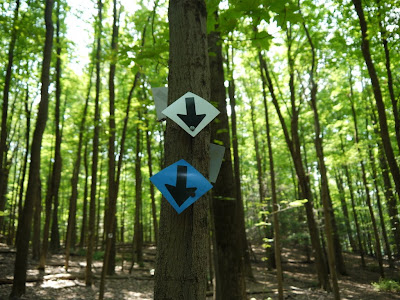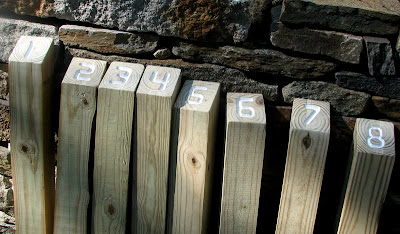The worst case is, of course, when they don't use any markings at all when there are multiple trails. Good luck with that.

Next comes the trail that are at least marked, but with spray paint. I often find this at small local land trusts which don't have enough volunteer help, don't realize there is a right way to do it, and let a well-intentioned Scout loose with a can of paint. The picture above, though, is at a state park. Go figure.
 Next are the metal or plastic markers that are nailed on. They usually look nicer than spray paint. Some are small and not too obtrusive, although larger ones, in my opinion, just don't look very attractive in the forest compared to proper blazes. They protrude from the trees. They don't blend in enough. They don't "belong." Yes, they are much easier to apply and save time in the short run. In the long run, though, they are also very easy to tamper with. People can pull them off and put them back on in the wrong spot. Arrows present an additional problem, as illustrated above. The blue and white trails are diverging in a "Y", but I found the arrows both pointing towards the ground and would have missed my blue turnoff if I wasn't paying very close attention.
Next are the metal or plastic markers that are nailed on. They usually look nicer than spray paint. Some are small and not too obtrusive, although larger ones, in my opinion, just don't look very attractive in the forest compared to proper blazes. They protrude from the trees. They don't blend in enough. They don't "belong." Yes, they are much easier to apply and save time in the short run. In the long run, though, they are also very easy to tamper with. People can pull them off and put them back on in the wrong spot. Arrows present an additional problem, as illustrated above. The blue and white trails are diverging in a "Y", but I found the arrows both pointing towards the ground and would have missed my blue turnoff if I wasn't paying very close attention. Any idiot can turn the arrows, and so I did. This is the direction they should have been pointing.
Any idiot can turn the arrows, and so I did. This is the direction they should have been pointing. In contrast, this triple diverging trail point at Sleeping Giant State Park cannot easily be tampered with. Red diamond and the blue trails go right; lavender trail goes left. No confusion except amongst people who haven't learned the basics on how to read trail blazes (If you are one of those: The upper blaze indicates the direction of the turn. There. Now you can follow any blazed trail system).
In contrast, this triple diverging trail point at Sleeping Giant State Park cannot easily be tampered with. Red diamond and the blue trails go right; lavender trail goes left. No confusion except amongst people who haven't learned the basics on how to read trail blazes (If you are one of those: The upper blaze indicates the direction of the turn. There. Now you can follow any blazed trail system). The Connecticut Forest and Parks Association sets a wonderful example. Their blazes are easy to see, but don't hit you over the head, and seem to belong in the forest. They have a set standard so that blazes are consistent throughout Connecticut even though they are painted by many different volunteers. Blazes are to be 2x6", a certain shade of blue that shows up well at dusk or in fog (photo above), a certain brand of paint, BRUSHED on. This is very time consuming, but the results are worth it.
The Connecticut Forest and Parks Association sets a wonderful example. Their blazes are easy to see, but don't hit you over the head, and seem to belong in the forest. They have a set standard so that blazes are consistent throughout Connecticut even though they are painted by many different volunteers. Blazes are to be 2x6", a certain shade of blue that shows up well at dusk or in fog (photo above), a certain brand of paint, BRUSHED on. This is very time consuming, but the results are worth it. The above blaze is an example of how CFPA used to mark side trails. They now have the secondary color at the end of the blaze so they don't have to wait for the first color to dry. When the blazes grow too wide from tree growth, they are resized with a dark brown spray paint. Basically, with 825 miles to blaze, they've got it all figured out.
The above blaze is an example of how CFPA used to mark side trails. They now have the secondary color at the end of the blaze so they don't have to wait for the first color to dry. When the blazes grow too wide from tree growth, they are resized with a dark brown spray paint. Basically, with 825 miles to blaze, they've got it all figured out. The blue blaze is readily visible if you're looking for it. Otherwise you might not even notice it.
The blue blaze is readily visible if you're looking for it. Otherwise you might not even notice it. Sleeping Giant has so many trails, they've had to be creative. They have red, blue, violet, orange, green, yellow and probably some other colors I've forgot, as well as different shapes for five red trails (square, triangle, circle, diamond, and hex). There's a black square with a white horseshoe for a bridle trail, and this black square with an "X" (or swords or whatever they are). And not a single sign, but you don't need signs if you have a map.
Sleeping Giant has so many trails, they've had to be creative. They have red, blue, violet, orange, green, yellow and probably some other colors I've forgot, as well as different shapes for five red trails (square, triangle, circle, diamond, and hex). There's a black square with a white horseshoe for a bridle trail, and this black square with an "X" (or swords or whatever they are). And not a single sign, but you don't need signs if you have a map. Signs are stolen pretty quickly, and can also clutter up a park with "sign pollution." Tarywile Park in Danbury has waymarkers throughout the park. The number "2" above corresponds with a "2" on the map. These are great if you have several points where the red and yellow trail come together, for example, and you're not sure which intersection you're at. Of course that does assume you came prepared and brought a map.
Signs are stolen pretty quickly, and can also clutter up a park with "sign pollution." Tarywile Park in Danbury has waymarkers throughout the park. The number "2" above corresponds with a "2" on the map. These are great if you have several points where the red and yellow trail come together, for example, and you're not sure which intersection you're at. Of course that does assume you came prepared and brought a map. In Shelton, that inspired us to create and install some of our own waymarkers.
In Shelton, that inspired us to create and install some of our own waymarkers.
Here's another form of waymarker at Trout Brook Valley. These are very helpful in identifying one's location, although this particular waymarker is not as rustic and "quiet" as I prefer.




1 comment:
Your summary of letterboxing and geocaching at borntoexplore.org is excellent. However, it is out of date in one respect: The National Park Service *has* changed its policy, effective October 2007. You can read the new policy at:
http://www.nps.gov/policy/GPSguidance.pdf
-- Kirbert
Post a Comment